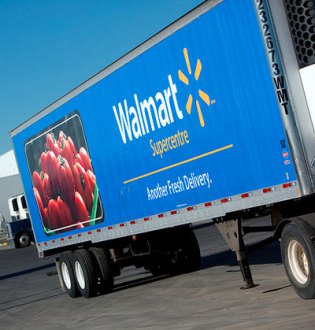Super Walmart's And Their Impact On Poverty
Topic: COMMUNITY INTEREST
Super Walmart's And Their Impact On Poverty

One morning waiting for my cup of coffee at 7am at Risoldi's grocery store on Quaker Bridge Road, I came across a new small gazette. The name of the gazette is The Hamilton Community Gazette. I began reading the Aug 20-27,2015 issue. As I waited for my coffee, I found an article entitled," Hamilton Looks To Fill A Desert". The article focused on the revitalization of the old Suburban Plaza in Hamilton, Mercer County.
The article focuses on an interview with the local Mayor of Hamilton. Evidently the Mayor is quite excited by the project. She feels it will breathe new life into the shopping center. The Mayor goes on to say," This component (meaning the Super Walmart), will not just help fill a food desert, but build on the economy of our residents." She continues to say," It will bring food access to portions of the town that previously lacked access to food."
What is the real impact, from a health perspective, that the residents of Hamilton will experience from this new Super Walmart? We interviewed some workers at a Super Walmart,reviewed the research studies done by the USDA, and University of Pennsylvania that focus on Walmart's effect on communities as it pertains to poverty. Here is what we found.
One of the employees we spoke to said, "I would never buy fresh food here." Bagged salads, this employee claimed, are often past their sell-by dates and, in the summer, fruit is sometimes kept on shelves until it rots. “They say, ‘We’ll take care of it,’ but they don’t. As a cashier, you hear a lot of people complain,” they said.
This employee blames the problems on the store’s chronic understaffing and Walmart’s lack of respect for the skilled labor needed to handle the nation’s food supply. At their store, a former maintenance person was made produce manager. He’s often diverted to other tasks. “If the toilets get backed up, they call him,” they said.
Another employee who worked in the produce section of a Walmart store reported much the same. “They put a 20-year-old from electronics in charge of the produce department. He didn’t know anything about food,” they said. “We had a leak in the cooler that didn’t get fixed for a month and all this moldy food was going out on the floor.” Walmart doesn’t accept the idea that “a supermarket takes any skill to run,” they said. “They treated the produce like any other kind of merchandise in the store. An apple has the same clout as a tshirt.”
That’s plenty to give a shopper pause, but it’s just the tip of the iceberg when it comes to reasons to be concerned about Walmart’s explosive expansion into the grocery sector. Why any town would embrace this in an urban area is beyond any rational understanding.
In just a few short years, Walmart has become the most powerful force in our food system, more dominant than Monsanto, Kraft, or Tyson.
It was only 23 years ago that Walmart opened its first supercenter, a store with a full supermarket inside. By 1998, it was still a relatively modest player with 441 supercenters and about 6 percent of U.S. grocery sales. Last year, as its supercenter count climbed above 3,000, Walmart captured 25 percent of the $550 billion Americans spent on groceries.
As astonishing as Walmart’s national market share is, in many parts of the country the chain is even more dominant. In 29 metro markets, it accounts for more than 50 percent of grocery sales.
Seeking an even bigger piece of the pie, Walmart is campaigning to blanket New York, Chicago, Washington, D.C., and other big cities with its stores. It has made food the centerpiece of its public relations strategy. In a series of announcements over the last year, Walmart has deftly commandeered high-profile food issues, presenting itself as a solution to food deserts, a force for healthier eating, and a supporter of local farming.
It is a remarkably brazen tactic. On every one of these fronts, Walmart is very much part of the problem. Its expansion is making our food system more concentrated and industrialized than ever before. Its growth in cities will likely exacerbate poverty, the root cause of constrained choices and poor diet. And the more dominant Walmart becomes, the fewer opportunities there will be for farmers markets, food co-ops, neighborhood grocery stores, and a host of other enterprises that are beginning to fashion a better food system — one organized not to enrich corporate middlemen, but to the benefit of producers and eaters.
Walmart’s rise as a grocer triggered two massive waves of industry consolidation in the late 1990s and early 2000s. One occurred among supermarkets, as regional titans like Kroger and Fred Meyer combined to form national chains that stood a better chance of surviving Walmart’s push into groceries. Today, the top five food retailers capture half of all grocery sales, double the share they held in 1997.
The second wave of consolidation came as meatpackers, dairy companies, and other food processors merged in an effort to be large enough to supply Walmart without getting crushed in the process. The takeover of IBP, the nation’s largest beef processor, by Tyson Fresh Meats is a prime example. When Tyson bought IBP in 2001, they said they had to do that in order to supply Walmart. The market saw horizontal integration in the meat business because of worries about access to the retail market. Four firms now slaughter more than 80 percent of cattle. A similar dynamic has played out in nearly every segment of food manufacturing.
The consolidation of the last two decades has created a food chain that’s shaped like an hourglass. There are a handful of middlemen now stand between 2 million farmers and 300 million eaters.
Their tight grip on our food supply has, rather predictably, come at the expense of both ends of the hourglass. Grocery prices have been rising faster than inflation and, while there are multiple factors driving up consumer costs, some economic research points to concentration in both food manufacturing and retailing as a leading culprit.
Farmers, meanwhile, are getting paid less and less. Take pork, for example. Between 1990 and 2009, the farmers’ share of each dollar consumers spent on pork fell from 45 to 25 cents, according to the USDA Economic Research Service. Pork processors picked up some of the difference, but the bulk of the gains went to Walmart and other supermarket chains, which are now pocketing 61 cents of each pork dollar, up from 45 cents in 1990.
Another USDA analysis found that big retailers have used their market power to shortchange farmers who grow apples, lettuce, and other types of produce, paying them less than what they would get in a competitive market, while also charging consumers inflated prices. In this way, Walmart has actually helped drive overall food prices up. This cannot be what any town leadership wants.
Last year, Walmart announced that it would double the share of local produce it sells, from 4.5 to 9 percent, over six years.
This doesn’t necessarily mean shoppers will soon find a variety of local produce at their nearest Walmart, however. Walmart counts fruits and vegetables as local if they come from within the same state. It can achieve much of its promise by buying more of each state’s major commodity crops, such as peaches in Georgia and apples in Washington, and by using big states like California, Texas, and Florida, where both supercenters and large-scale farming are prevalent, to pump up its national average.
It speaks to the weakness that we’ve all known about, which is that ‘local’ is an inadequate descriptor of what we want. It’s not just geography; it’s scale and ownership and how you treat your workers. Walmart is doing industrial local.
Walmart’s sourcing is becoming somewhat more regional, but the change has more to do with rising diesel prices than a shift in favor of small farms. It’s a sign that Walmart’s Achilles heel — the fossil-fuel intensity of its far-flung distribution system — might be catching up with it. According to the Wall Street Journal, trucking produce like jalapeños across the country from California or Mexico has become so expensive that the retailer is now seeking growers within 450 miles of its distribution centers.
Walmart sees the writing on the wall. They know the cost of shipping from California back to Georgia and Mississippi is high now. This skepticism is shared by many farmers. If multimillion-dollar companies like Rubbermaid and Vlasic can be brought to their knees by the retail behemoth, how should we expect small farmers to fare?
Walmart’s promise to increase local sourcing is reminiscent of its pledge five years ago to expand its organic food offerings. They held true to their corporate model and tried to do organics the same way. For its store-brand organic milk, for example, Walmart turned to Aurora Organic Dairy, which runs several giant industrial milking operations in Texas and Colorado, each with as many as 10,000 cows. In 2007, the USDA sanctioned Aurora for multiple violations of organic standards. Earlier this year, the agency stepped in again, this time revoking the organic certification for Promiseland Livestock, which had been supplying supposedly organically raised cows to Aurora.
These days, Walmart’s interest in organic food seems to have ebbed. What has been observed is that Walmart sells fewer organic products and produce now than four years ago. Today, the proportion of their sales that is organic is the lowest of any major supermarket chain.
Walmart has renewed its push to get into big cities, after trying and failing a few years ago. This time the company has honed a fresh strategy that goes right to the soft underbelly of urban concerns. In July, Walmart officials, standing alongside First Lady Michelle Obama, pledged to open or expand as many as 300 stores "in or near" food deserts.
Walmart sees underserved neighborhoods as a way to edge its nose under the fence and then do what it’s done in the rest of the country: open dozens of stores situated to take market share from local grocers and unionized supermarkets. For example, an analysis by Manhattan Borough President Scott Stringer’s office estimates that if Walmart opens in Harlem, at least 30 supermarkets, green grocers, and bodegas selling fresh produce would close.
For neighborhoods that are truly underserved, it seems hard to argue with the notion that having a Walmart nearby is better than relying on 7-11 and McDonald’s for meals. But poor diet, limited access to fresh food, and diet-related health issues are a cluster of symptoms that all stem from a deeper problem that Super Walmart is likely to make worse: poverty. Poverty has a strong negative effect on diet quality, a 15-yearstudy recently concluded, and access to a supermarket makes almost no difference. I guess some political figures are unaware of these studies and their effect on communities.
Neighborhoods that gain Super Walmart stores end up with more poverty and food-stamp usage than communities where the retailer does not open, a study published in Social Science Quarterly found. This increase in poverty may owe to the fact that Walmart’s arrival leads to a net loss of jobs and lowers wages, according to research by economists at the University of California-Irvine and Cornell.
Super Walmart stores have also been linked to rising obesity. An additional supercenter per 100,000 residents increases the obesity rate by 2.3 percentage points. These results imply that the proliferation of Walmart supercenters explains 10.5 percent of the rise in obesity since the late 1980s.
Improving the health of a community is critical not only in enhancing residents’ quality of life but also in supporting its future prosperity. Similar to trends nationwide, issues around obesity—particularly healthy eating and physical activity—are important health concerns in the area that are associated with prevalent chronic conditions such as heart disease and diabetes.
Specifically, 25% of Mercer County adults are considered obese, slightly higher than what is seen in New Jersey but lower than national rates. Limited transportation, affordability of healthy foods and recreational facilities were cited as challenges to accessing existing resources.
Similar to trends nationwide, issues around obesity—particularly healthy eating and physical activity—are important health concerns in the area that are associated with prevalent chronic conditions such as heart disease and diabetes. Specifically, 25% of Mercer County adults are considered obese, slightly higher than what is seen in New Jersey but lower than national rates. Limited transportation, affordability of healthy foods and recreational facilities were cited as challenges to accessing existing resources.
Heart disease was the leading cause of inpatient hospitalization among Mercer County adult patients 18-64 years old (2.95 per 1,000 population) with the largest rate recorded among Pennington patients (9.01 per 1,000 population). Heart disease was followed by asthma (0.88 per 1,000) and diabetes (0.86 per 1,000) in Mercer County, which was consistent with the municipality data. Heart disease was also the leading cause of hospitalization in Mercer County (36.68 per 1,000) for the elderly (aged 65 and older). The inpatient hospitalization rate for heart disease among patients from Pennington was over three times higher than the county at 110.87 per 1,000 population, while Ewing’s rate was smallest at 11.56 per 1,000. The second leading cause of inpatient hospitalization for the elderly in Mercer County was for stroke (20.11 per 1,000 population) with Trenton’s rate notably higher at 78.07 per 1,000 population, followed by fractures (10.59 per 1,000) DATA SOURCE: New Jersey Department of Health and Senior Services, Office of Health Care Quality Assessment.
The bottom line for poor families is that processed food is cheaper than fresh vegetables — and that’s especially true if you shop at Walmart. The retailer beats its competitors on prices for packaged foods, but not produce. An Iowa study found that Walmart charges less than competing grocery stores for cereals, canned vegetables, and meats, but has higher prices on most fresh vegetables and high-volume dairy foods, including milk.
We stand to lose a lot if Walmart keeps tightening its grip on the grocery sector. Signs of a revitalized food system have been springing up all over — farmers markets, urban gardeners, neighborhood grocers, consumer co-ops, CSAs — but their growth may well be cut short if Walmart has its way.
People need to keep an eye on the values that are at the root of what is driving so much of this activity around the food system.
Walmart is pushing us toward a future where food production is increasingly industrialized, farmers and workers are squeezed, and the promise of fresh produce is used to conceal an economic model that leaves neighborhoods more impoverished. Are we going to let it happen, or are we going to demand better food and a better world? This also has an extremely negative effect on the cost of healthcare as well.
The six Waltons on the Forbes 400 list—Christy, Alice, Jim, Rob, Ann, and Nancy—are worth a combined $148.8 billion. According to the most recent data available, they have the same wealth as the bottom 42% of American families combined. Walmart associates, in comparison, have been risking arrest in their fight for $25,000 a year for full time work.
Here are the facts.
Fact: Walmart is a job killer.
Walmart store openings destroy almost three local jobs for every two they create by reducing retail employment by an average of 2.7 percent in every county they enter.
Walmart cost America an estimated 196,000 jobs – mainly manufacturing jobs – between 2001 and 2006 as a result of the company’s imports from China.
Fact: Walmart jobs are poverty jobs.
Walmart workers average just $8.81 hour. This translates to annual pay of $15,576, based on Walmart’s definition of full-time. This is less than two-thirds of the poverty line for a family of four, and well below what most families actually need to get by.
According to the company, most workers make less than $25,000 a year. In a presentation, Walmart US CEO Bill Simon included the fact that out of all Walmart associates in the country, only 475,000 make more than $25,000 a year.
Walmart pays less than other retail firms. A study found that Walmart workers earn an estimated 12.4% less than retail workers as a whole and 14.5% less than workers in large retail in general.
Last year, Walmart slashed already meager health benefits again, dropping health insurance for new hires working less than 30 hours a week and leaving more workers uninsured.
Fact. Super Walmarts are built in areas that Walmart where Walmart depends on the poverty in an area to drive their profits. They do very thorough analysis of the areas they enter. Walmarts executives obviously understand what is really happening in Hamilton more than the executives that run the town.
Fact: Taxpayers are paying the price for Walmart.
Taxpayers subsidize Walmart’s low wages and poor benefits. Just one Walmart store costs taxpayers an estimated $1 million in public assistance usage by employees, according to a new report from the Democratic staff of the U.S. House Committee on Education and the Workforce. In many of the states across the country that release such information, Walmart is the employer with the largest number of employees and dependents using taxpayer-funded health insurance programs. A few examples:
In Arizona, according to data released by the state , the company had more 2,700 employees on the state-funded plan.
The company also topped the list in their home state of Arkansas, with nearly 4,000 employees forced onto the state’s plan according to data released by the state.
In Massachusetts, taxpayers paid $8.8 million for Walmart associates to use publicly subsidized healthcare services.
Despite all the damage they have done to US workers and communities, another study found that, as of that date, Walmart had received more than $1.2 billion in tax breaks, free land, infrastructure assistance, low-cost financing and outright grants from state and local governments around the country. This number has surely increased as Walmart continues to receive additional subsidies.
So, how much is this Walmart really costing Hamilton taxpayers in the end? Does Angarone and Yaede know the answer to this....clearly not.
Posted by tammyduffy
at 7:18 PM EDT
Updated: Thursday, 27 August 2015 6:52 PM EDT

























